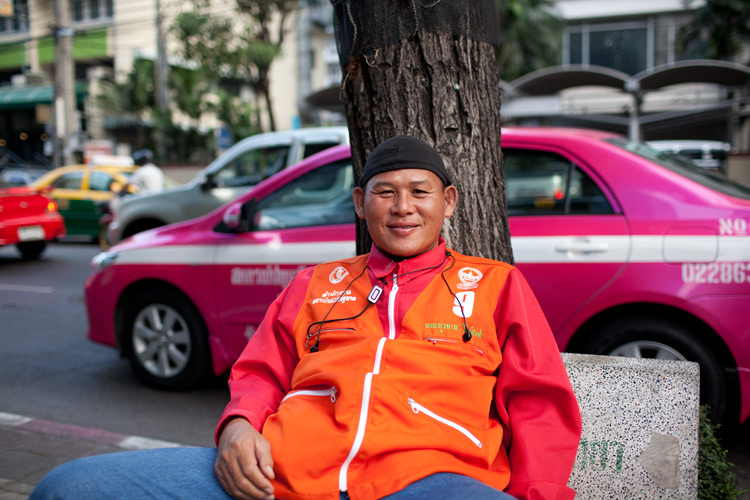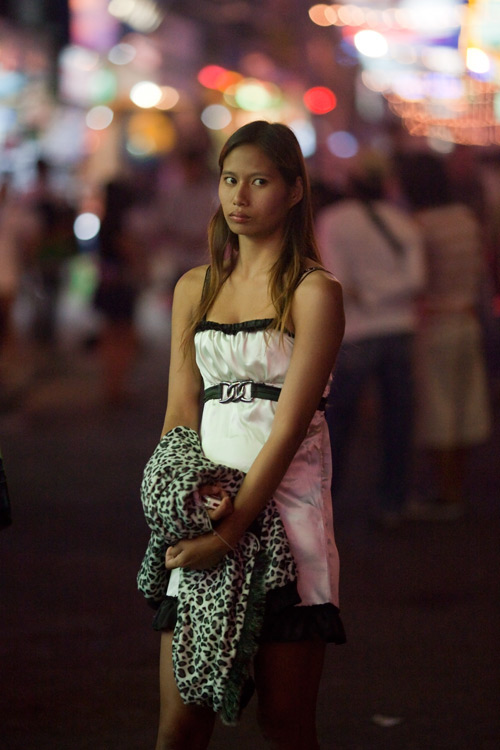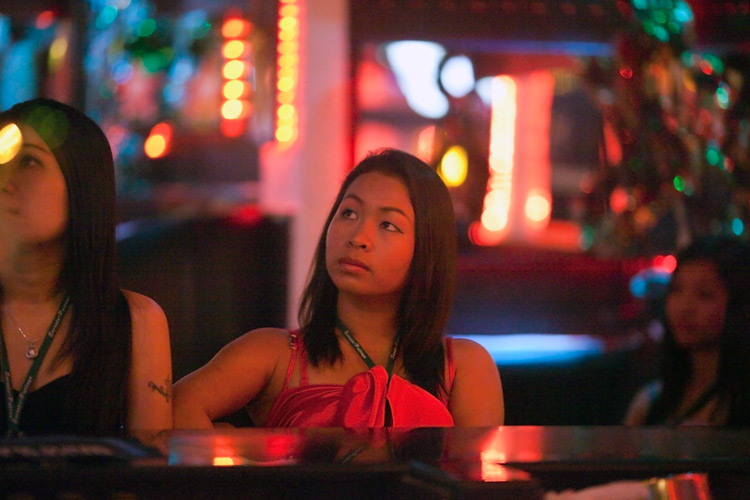Megapixel Hoax!/5d Mark II In-Depth User Report

|
• Byron Lakeside Apartments Hotel • Peppers Casuarina Lodge Hotel • Bay Village Tropical Retreat Hotel • Best Western Cairns Hotel |
Feature Photograph

This week's feature photograph is significant because it supports the main theme of this week's column: It’s not the camera! This image was captured on a $65 pawn shop Olympus OM-1n film SLR using a $25 pawn shop 28mm F2.8 Zuiko lens, captured on a Fuji Velvia positive (slide film), scanned on a $120 document scanner, and was selected as the cover photograph for a RV magazine and the feature photograph of a On The Road Travel Weekly. This image was captured roughly 15 years ago!
We were on a family vacation in our YJ Jeep pulling a small motorcycle trailer through Death Valley on our way to the Luxor in Las Vegas. The road was totally empty and the scene caught my eye as I’ve always wanted to lay in the middle of a US Highway, put the camera on the ground, and take such a photograph. I stopped the Jeep and did just that as the wife and son looked on in amusement wondering why I’d leave the air conditioned sanctuary of the Jeep's interior. Velvia slide film was and still is expensive so I metered carefully, composed carefully, and took the one shot.
A few hours later we stopped atop Davis Dam and I pulled out the tripod and 600mm Zuiko from its metal case and set up to photograph a jet ski competition. The wife and son remained in the air-conditioned refuge of the Jeep's interior and soon started complaining about me taking so long to take a few pictures. I carefully packed up my gear making sure to put my ultra-expensive 600mm Zuiko carefully in its metal case. Not even 30 minutes later I realized I’d never put the metal case back in the Jeep, I’d left it sitting on the low stone wall of the viewpoint and drove away! Driving back as quickly as I dared, of course the lens wasn’t there. We had the makings of a memorable vacation..
The next day we made it to Vegas, checked into a nice suite at the Luxor and washed the dust off. During the tour of the King Tut exhibit I mounted my favorite Zuiko F1.2 50mm lens and put in a roll of Ektachrome ASA 800 slide film. I held on to the camera and lens tightly and to this day both body and lens are sitting in my display cabinet with my other retired equipment.

Pattaya / Canon 5D Mark II User Review by Stickman
Almost two years ago Stick and I took a few days and headed out on the road for a photographic tour of no where specific. Our goal was to get to know each other a bit better and share a hobby we both enjoyed. At the time we left I knew Stick’s equipment list consisted of a Canon 20D (1.6x crop DSLR) and some basic lenses and because he enjoyed photography so much I felt it was my civic duty to expose him to some more advanced (read expensive) equipment so he could look forward to his next purchase. I loaned him my original 5D for the entire trip and the full frame sensor and high image quality obviously wetted his appetite for an upgrade. At the time we both thought the new 5D replacement would be only months away, but the original 5D was so successful that Canon didn’t see fit to upgrade it for another two years.
As an aside, during our trip I remember Stick asking what advantages the $8000 USD Canon 1ds Mark II offered over the 5D. “Several I said, it’s a professionals tool.” I then handed him the 1ds Mark II with the 70-200mm F2.8 IS lens attached and said “try letting the autofocus track the license plates on the cars heading at us at 100kph.” After a few minutes he handed it back and said his 20D could never do that.. but best not to dream about a $8000 USD camera.. the $2999 USD 5D dream was quite enough and all that he needed as it will be for most.
The original 5D was ground breaking. Previously if you wanted a full frame DSLR you had to spend $8000 USD for a 1ds or the new 1ds Mark II. No consumer full frame model was available from any manufacturer. Then Canon announced the 5D at the list price of $2999 and it took the photographic world by storm! All of a sudden full frame DSLRs and their superior image quality became within reach of the well heeled amateur and hobbyist. The 5D became the industry standard for overall image quality and high ISO low noise performance. Even Nikon’s ground breaking 12mp (same pixel count as the 5D) D3 and subsequent D700 with four year newer technology couldn’t surpass the image quality of the original 5D below ISO 1600. They did raise the bar in image quality with higher ISO performance from 1600 – 25600. However, for nearly four years the Canon 5D was the ONLY full frame option for those not wanting to plunk down $8000 USD for a Canon 1ds Mark II and later the 1ds Mark III.
As we speak the 5D’s replacement, the 5D Mark II is hitting the shelves of camera stores the world over. And it’s offering the same 21 megapixel count on a full frame sensor as the $8000 USD Canon 1ds Mark III! The sensor in the 5D Mark II is newer technology than the one used in the Canon 1ds Mark III and the 5D Mark II offers newer tech features over the 1ds Mark III like a bigger LCD with a lot more resolution, HDTV 1080p movie mode and more. For $5000 USD less!!! There are legitimate reasons to choose the 1ds Mark III over the 5d Mark II despite the $5000 USD price premium, but these reasons won’t apply to most, only the professionals who need the advantages of the 1d series body. The original 5D became a legend and image quality benchmark, and the 5D Mark II promises the same. Rob over at www.1ds.com gave us a taste of the new 5D Mark II a few weeks ago, and this week Stick brings us another user report that I believe will be valuable to those considering the same upgrade.
This starts Stick’s User report.
I am not an impulse buyer. I take time before I buy a new product and the more the product costs, the longer I linger over the purchase decision. You’d therefore think that the 100,000 odd baht Canon 5D Mark II would have been something I’d pain over for a long time before making the purchase decision. Wrong! Within 30 minutes of the first tiny shipment of Canon’s latest wonder toy arriving in my local camera store I had plunked down the readies for the baby 1DS III and picked up a 35mm 1.4L for good measure.
Why the impetuousness? Like BKKSW, I love photography and I keep abreast of the latest developments in the photography world. After using BKKSW’s original 5D 2 years ago when we took a small photographic tour together, I had been in love with full-frame. I’ve been waiting for the 5D II long before it was announced in September and had had a quiet word with my local store about getting one when it arrived.
What you need to understand is that I currently own a Canon 20D and as such have gone down the Canon path. Professionals tend to use one of either Nikon or Canon – with some pros using both although that could get very expensive. It is not just the camera but the system you buy into and as I am in the Canon system, so to speak, the 5D II was the natural upgrade choice for me.
Consider this a real world review, not a pixel peeper’s technical analysis. The destination of choice to try out the mark II was Pattaya, a city that comes alive at night. How would the 5D II’s auto focus cope in the low light of the Pattaya evening? Would the high ISO exceed that of the original 5D? Read on!

General Handling
The 5D II feels good in the hand and has a solidity about it that the 20D was lacking. That said, I slipped over a couple of times with the 20D and dropped it once and you could barely make out a scratch. The 5D II again inspires confidence. Playing around with it the day I bought it a friend suggested that I should keep it in a bag to keep it new and shiny. No way Jose! My camera is a tool and while I do not wish to see it scuffed and marked, I have confidence that it will take the knocks and bumps and continue to work well for me. That’s what I like so much about the 5D II. It inspires confidence.

Auto Focus
Much has been made of the fact that the 5D II uses the same auto focus system as found in the original 5D. It is fast and accurate. Very accurate. In fact there is a certain surety about it that gives confidence that it nails the focus first time, every time. Wandering around Bangkok and Pattaya late at night and shooting in very low light I found the focus locked on to my subject every time. Amazingly, I have not had one out of focus shot yet!
Compared to my 20D, the focus is more accurate and this instills a certain confidence in the photographer. The 20D’s focus was as fast, but it was "temperamental". With the 24–70L attached, the 20D nailed focus 99.9% of the time but with other lenses you’d find 5% of shots were mysteriously out of focus – even in ideal light. And with the 70-200 F4L it really could be described as a bit of a lottery. That remains my only lens slower than 2.8 and it never really performed consistently on the 20D, at least in terms of focus. When it was good it was great, but there would be many occasions when it would miss focus in bright conditions for no apparent reason.
The 5D doesn’t hunt like the 20D did in low light and while it may not be quite 1-series accuracy, I tell you, it is more than good enough for me and as such I’d guess it’s more than good enough for most. If you have decent technique, I really cannot see any reason to complain about the autofocus system. Even in very dimly lit bars the 5D didn’t hunt AT ALL. It locked on the target and held it.
The AI servo works great and I had no problem capturing fast moving targets like motorcyclists roaring around Pattaya, as can be seen from the shot below.

(Both the 20D and the 5D Mark II have 9 AF sensors and the same basic AF scheme. However, the 5D Mark II does offer some not so obvious upgrades that explain the performance difference Stick describes. In the 20D only the center AF sensor was a “cross-type”, which means it detects motion in both the horizontal and vertical planes making it twice as sensitive as the other 8 AF sensors. In the 5D Mark II ALL 9 AF sensors are cross-type, and if you use a F2.8 lens they’ll all be activated and at full sensitivity. The way the sensors work exactly in relation to the largest available aperture is beyond the scope of this user review, but if you care to look on page 87 of the 5D Mark II manual it is well documented. Also, the AF programming in the firmware is constantly tweaked and upgraded with newer models — BKKSW)
Image quality
I cannot explain just quite how good the image quality from this baby is; superlatives really don’t do it justice. The images literally leap off the screen at you and the level of detail as well as the ridiculously low amount of noise is breathtaking. Even with no tinkering in Photoshop whatsoever,
as per the snap of the motorcycle taxi rider below, they have real punch and just plain look great right out of the camera. Whereas the files from my 20D often needed some work in Photoshop to give them that "pop", the 5D II files out
of the camera are phenomenal!

ISO Performance
There is ZERO noise from 100 – 400 and zero noise at 800 ISO if you expose correctly. 800 ISO really is as clean as a whistle and no different to 200 ISO on the 20D. Noise arrive starts to rear its ugly head from 1000 ISO up but even at 1600 ISO it is very, very mild and not an issue at all. You have to view an image at 100% on a monitor to see it – in other words, it is not really noticeable at all. By 3200 ISO noise is apparent but still hardly an issue and in fact all the way to 6400 ISO, if you nail the exposure noise is not problematic. I imagine that printed images at 6400 ISO would look just fine although I must admit I have yet to test that theory. 3200 ISO images that were properly exposed on the 20D looked just great printed so I think I can safely say that any decently exposed image from the 5D is going to look even better. (Smaller prints show much less noise than larger prints, you’ll find that 4×6” or 5×7” prints will look great from the 5D Mark II even at the highest ISO’s if the image was properly exposed. – BKKSW)
It has to be said that while noise is not an issue, colour tone and contrast starts to drop at 3200 ISO. The noise level is no real issue but the colours lack a little saturation and need a tweak or two in post processing.

12800 remains quite useable whereas 25600 ISO would really only be used in a pinch and would remain best as an option for images that will just be shown online. That said, these high ISO levels become somewhat obsolete if you have fast glass. Match the affordable 50mm 1.4 with the 5D II and you will never need to go even as high as 6400 ISO! 12800 and 25600 become academic.

Battery Life
Canon claims that the battery life of the 5D II is much improved over the mark I. I ripped off 550 shots in Pattaya and was examining and pixel peeping every other shot so I was using the LCD a lot. Also, as I was shooting people moving and motorcycles roaring around the streets I often used AI Servo which can drain the battery. I charged before I left Bangkok and did not need to charge again before I returned. The battery level indicator showed that there was around 1/3 battery charge remaining indicating that shooting several hundred shots with much LCD screen use is quite possible on one charge.
Overall
One of the unnecessary accessories I bought with the 20D was an extra battery and I don’t think I will make that mistake again. I seldom shoot more than 250 – 300 shots in one shoot before returning to base so one battery should suffice. (In my opinion a spare battery is cheap insurance. It’s not so much about the battery running out of juice, which it will do much quicker as the battery ages, but it’s more about the risk of the battery failing. Everyone with a cell phone, IPod, laptop, or other device running off a lithium-ion battery knows how these batteries can be perfectly fine one day, and stop working for no apparent reason the next. A charged spare battery is cheap insurance and a solid practice. — BKKSW)
What don’t I like about the camera? It’s pretty hard to find anything to gripe about really. If I had one small complaint, it would be that the information in the viewfinder is a little dim. It could have, even should have, been brighter. But that is nitpicking and it really is about the only issue I can find with the camera. Some say there should be less plastic in its construction. Nonsense. It is built like a little tank. Ah yes, perhaps a flash would have been useful. There was one shot I took during daylight hours which really needed just a little fill flash to brighten the subject. There seems to be a notion that on a semi professional level camera a fill in flash is not appropriate but I cannot say I agree with that.
I guess also the fact that the files the camera produces are so big is a bit of a pain. but we can blame that more in the fact that I am processing them on a 3-year old laptop. A new computer with a faster processor and more RAM would make a much better fist of handling the files.
(Great User Review!!! Thanks Stick! I’m looking forward to more of your images! — BKKSW)
Anti-Megapixel Rant
Regrettably this week's feature photograph and the photographs in this section could not be of Thailand subjects. I’d have preferred them to be, but I wanted to make a point about the image being about the photographer and not the camera and going back 5-12 years for examples I discovered I wasn’t in Thailand during the periods I used certain cameras. Still, I hope you’ll find the samples and explanations as useful as ever.
In the last 6-12 months we’ve had a record number of DSLRs come on the market and I get many questions about which camera is the best and why, if someone should upgrade from their “old” model to a new model (often at a cost of $3000-$8000 USD), and if the new camera will allow them to take better pictures. The answers are as varied as are the skills of the people asking the questions. Certainly the newer cameras have higher image quality in most cases and useful new features. The real question is if the individual asking the question(s) would benefit at their current skill level and with their current needs and type(s) of photography. In most cases the answer is “yes, but only marginally.” By marginally I mean by a barely perceptible / visual amount. The exception to this would be those upgrading from a non-DSLR or someone upgrading from a APC sized DSLR to a full frame DSLR. There is a huge difference in features and image quality between a consumer point and shoot and ANY DSLR, or the small APC DSLR sensor and a full frame DSLR sensor.
And then there’s the famous “the new model has more MEGAPIXELS, isn’t this important? Won’t my pictures look better if I shoot a DSLR that can capture 21mp instead of my 8mp model?” And of course even the consumer point and shoot market is being hyped by the marketers claiming more megapixels make a better camera. Everyone seems to be impressed by more megapixels! It’s not about the megapixels, it’s about the person pressing the shutter release.
What exactly will more megapixels do for you? Under optimum conditions they will provide marginally more detail in the scene allowing you to make bigger prints or perhaps more useful allow you to crop the image to taste to a greater degree after the image is captured. Most of the samples I’m about to show you were captured using a Nikon D2h 4mp DSLR. Yes, you heard right, only 4mp! And I’ve sold many 20×24” prints from these files! How much bigger will you print? 20×24 inches is a pretty big print. Yes, when I upgraded to my Canon 1dsMarkII with 16.7 megapixels I had more detail in my images, but not enough for the average person looking at prints of the same scene to be able to pick out with any degree of reliability which camera produced which print. I purchased the Canon 1dsMarkII for reasons other than megapixels. I do admit, the extra megapixels allow me to crop after the fact for a more pleasing composition and still maintain enough megapixel real estate for a good sized print, but I wouldn’t upgrade my camera just for this feature.

This image of the eagle was captured with the Nikon D2h 4mp camera, the lens was wide open at F2.8, the shot was hand held, and the ISO was set to ISO 1000!!! To further make my point as I’m sure you can see how sharp this image is, how defined the eye and the tines of the feathers are, this is a crop of the main image (eagles are difficult to get close to), about 10% of the original 4mp frame!

From the same outing, I captured several hundred eagle pictures that day, all more or less of the same sharpness and quality.

This shot is of an African Crane at a wildlife park. The crane is in standby mode. This was also shot at F2.8, handheld, but at ISO 200. This image like all the images here have been reduced by a factor of roughly 5x for web presentation. The original makes excellent 20×24” prints.

From the same outing, same African Crane, but no longer in standby mode.

This is an elk in the wild from a distance of about 200 meters. Same lens and body as the shots above, same F2.8 aperture, handheld, ISO 200. The amount of detail in the full size original is amazing.

I know some will ask “a capture of an animal is great, but what about a landscape with much more detail?” Above is your answer. This shot of Crater Lake is also reduced by a factor of 5x for web presentation. It was taken with the Nikon D2h and Nikkor 12-24mm lens, handheld, F8. This one was published in a backpacking magazine. Only 4mp folks!

And someone else will ask “but is 4mp enough for portraits?” The above image is a crop, about 7% of the original frame, of a portrait I did with the 4mp D2h. This was has even been heavily “softened” because the detail was so extreme it showed all the skin pores. Notice the amount of detail in the iris of the eyes?

Just to drive home my point a bit the above shot was taken with a 2mp, yes 2mp, POINT AND SHOOT Olympus in 1998.. This is one of my favorite scenes. Sure, I wish I’d had the future Canon 1dsMarkII with me on this day and it probably would have made a better image. What was I doing with a point and shoot 2mp camera in this position after hiking for hours to get to this vantage point? I was using the point and shoot camera as a light meter for my film camera, the same $65 pawn shop special I used to capture this week's feature photograph. P&S cameras make excellent ‘live’ light meters which allow you to transfer the settings very near straight across. After dialing in the consumer 2mp point and shoot digital, I knew exactly which settings to use on my film SLR.
I understand getting the newest DSLR is a great deal of fun, but let’s not kid ourselves into believing the camera will make you a better photographer. Also, whenever new cameras come to market all the old cameras end up as excellent deals on EBay and other used venues. If you can’t afford or just don’t want to spend the money for the latest and greatest, perhaps your budget will allow the purchase of last year's barely used DSLR?
Photography News of Interest
Adobe Lightroom 2.2 has just been released and adds support for new cameras including the new Canon 5d Mark II. You can download it here.
Unfortunately there are already a few image quality issues with the new Canon 5d Mark II. Such issues are not uncommon on newly released DSLRs are armchair photographers do their very best to exploit even the tiniest flaws in an otherwise stellar product. Now we have a banding and ‘black dot’ phenomenon reported under conditions most will never experience, but forum jockeys across the World Wide Web are up in arms over the problems. Canon appropriately has responded acknowledging the problems and promising a forthcoming ‘fix’ in the way of a firmware upgrade. This means you probably won’t have to pack up your new Canon 5d Mark II and ship it off for weeks or more to your local service center. You can read Canon’s statement here.
A few weeks ago I posted a link to a comparison test of consumer point and shoot compacts. Great for most people, but what about enthusiasts and pros who would like to see a comparison of point and shoot compacts of interest to them? Digital Photography Review made such a comparison and you can compare the best of the breed when it comes to point and shoot compacts for pros and keen enthusiasts here.. See the comparison of the Canon G10, Panasonic Lumix DMC-T75, Nikon P6000 and more.
Making great images of children is a difficult skill to master. This article is very informative and highlights their 7 secrets of children’s photography. You might find it worth a read.
I found this article very interesting. Dan Burkholder has a exhibition of images captured post-Katrina focusing on the beauty found in the aftermath of Katrina. This might be an uncomfortable subject for many, but there’s no denying beauty can be found in almost anything if the photography has a keen eye. His work is outstanding! You can see it here.
I’m a big believer in quality calibration and measuring instruments. The number of questions I receive asking how to best use the “micro-adjustment” feature on the newer DSLRs to correct for lens front and back focusing are many. In the past we were limited to printing out specific test patterns on a piece of paper, setting up the camera, and doing our best to zero in the micro-adjustment for the most precise focusing. If your careful this will work, but this new system my LensAlign looks like it will make the entire process not only easier, but more accurate. Luminous Landscape reviews the new product here.
Now this is a really great thing. “Flashes of Hope” is a NGO who’s purpose is to capture young patients and their families during their most trying times. The portraits they produce are sometimes the child’s last portrait so you can imagine how meaningful this service is to the parents and other family members. Read about it here.
Readers' Submissions
There were no readers submissions again this week. If you have anything you’d like to share please send it in because feedback is very positive towards Readers Submissions.
I suspect the readers submissions will be a highly anticipated section of this column and I encourage anyone with photographs and travel accounts they d like to share to please send them to me at: QandA@Bkkimages.com
Readers' Questions
Steve;
You might remember I bought the original 5d almost two years ago and have really enjoyed it. Now I see the new 5dII in my local camera store and I’m wondering what you think? Will I see big improvements in my photography if I upgrade? I am trying to talk the wife into the 5dII as a Christmas gift but she says my current 5d is good enough and doesn’t believe a new camera will make better pictures of the kids and dog. Can you help convince the wife I need the new model?
I’ve learned much from your column and really enjoyed the Loy Kratong pictures!
Richard:
Richard –
I’d love to tell you the 5d Mark II will result in better pictures for you, heck I want one myself. The truth is I really doubt for your purposes you’ll see much if any improvement in image quality over your current 5d. Let me explain:
In past emails you’ve told me you rarely print over 11×14 and for the most part just share web images with family and friends. This is very common. With digital photography it becomes common to shoot 1000 exposures while only making a print of 1 exposure. We’ve substituted our computer monitors for slide projectors and the standard 4×6 prints and we only make real prints when we have something really special we want to send to others or put in a frame in our own homes.
The new 5d Mark II increases the megapixels from 11mp to 21mp. This is a significant difference, but not a difference you’re likely to see without a loupe at 11×14 inches unless you crop dramatically. The new 5d Mark II DOES increase dynamic range a bit and it even handles noise nearly as well despite the major bump in megapixels.
What the 5d Mark II offers over the 5d is mainly a bigger, brighter, and more detailed LCD which can be useful depending on your style of photography, a HDTV 1080p movie mode, more megapixels, auto-ISO, and a bit of refinement in the camera matrix metering and autofocus. Are any of these features worth $3000 USD’s to you? The movie mode I’d imagine will be fun to play with and its not a full features video camera.. more it’s a limited featured special purpose video capture device which allows you to use your lenses. To me the auto-ISO and better LCD are welcome features, but not features worth $3000 USD’s.
So, the answer is, if I had the original Canon 5d I would not upgrade to the new Canon 5d Mark II unless one of the new features was something I must have. This is the very same reason I didn’t upgrade my Canon 1dsMarkII to the new Canon 1dsMarkIII. There wasn’t enough difference between the models to justify the $8000 USD purchase price. Perhaps there will be when the new 1dsMarkIV comes out next year.
Hopefully this will help..
Steve
Please submit your questions to QandA@Bkkimages.com All questions will be answered and most will show up in the weekly column.
A Snapshot of Bangkok Images Week in Review
Another slow week. I’m happy to say that several clients have made it to Thailand and I’ll work with them next week.
Infocus Blog
Anything broken or in need of adjustment of cleaning?
I’ve known for a long time that quality electronic and camera repair in Japan was far superior to the same in America or perhaps anywhere else in the world. In the 1980’s I used amateur radio HF equipment from Japan and this gear sometimes required repair or adjustment. I’d already experienced the long wait times and high prices not to mention the poor attitudes of such repair centers in the states so the 1-3 day turnaround time, reasonable charges, and attention to detail from the Japanese repair centers was very welcome. Knowing the Japanese work ethic and their penchant for precision I wasn’t surprised. Over the next decade I had many more radios repaired, cleaned and adjusted and even started doing the same with my high –end stereo gear. Often in Japan you could get a $400 item repaired for $20-$30, while in the states the minimum service charge of over $150 made the equipment not worth repairing from a financial standpoint.
Several years ago I had the occasion to try out the Canon Photographic Repair Center in Bangkok. Some drunk knocked my brand new Canon G9 from my hands to the deck of the ship we were on and ruined the lens and a few other things. Canon Thailand accepted my USA CPS (Canon Professional Services) card for a 30% discount and had my G9 repaired overnight with a brand new lens assembly, total cleaning and adjustment, for a very reasonable fee. I immediately brought them all my Canon DSLR bodies and lenses where they cleaned and adjusted each one for baht 400 each, and then applied my CPS 30% discount! For a DSLR this included cleaning the mirror box, sensor, and exterior. For the lenses this included cleaning the filters, lens surfaces, clearing the dust from the interior, and then aligning the autofocus adjustment to the individual camera body I specified. A great service and the equipment looked like new when finished.
A few months later a electronic motor in an appliance burned out. A quick trip to Chinatown and 600 baht later I had the original motor rewound and working like new. They did it right on the street from a vendor cart while I watched. The replacement cost for this motor was baht 14,000!
Last year my uncle visited and one of his hearing aids went bad. He was upset because in the states you must take the broken hearing aid into the repair center, pay the minimum $179 service fee upfront, and then wait 2-3 weeks for it to be sent out and repaired. If you were lucky they’d loan you a loaner hearing aid. The only service they did in the “repair center” was battery replacement and cleaning and for the cleaning you needed to make an appointment weeks in advance and then you could wait while they did the cleaning.
We were in Pattaya when the hearing aid broke and less than 100 meters from our hotel we found a repair shop. They repaired the hearing aid while we waited, cleaned both of his hearing aids, replaced the batteries, and charged him baht 400 each. He was elated and super happy with the service. He asked while they couldn’t provide the same service in America?
Three days ago both of my Viewsonic professional series monitors went bad at the same time. I use these side by side in a dual monitor stand. They were both purchased at the same time and were two years out of warranty. I’m running a UPS so a power surge didn’t take them out, not sure what did. Professional image monitors are very expensive so I called around for a repair center in Bangkok. The Viewsonic repair center was less than 1km from my home. The technician thinks he can have both repaired by the end of the week, all he needs are two rectifier bridges shipped from Singapore. He estimates the total cost at about baht 1200 for the both of them. I have no reason to think he won’t be able to repair them within his estimate.
Asia is a great place for camera, electronics, and appliance repair. Instead of throwing out that broken cellphone, camera, printer, or blender.. consider finding a repair center and saving some serious money. I think you’ll be very happy with the results.



